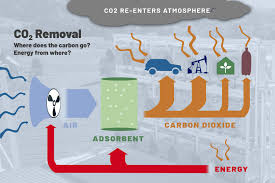What is Direct Air Capture?

Direct Air Capture (DAC) refers to a set of technologies that can capture carbon dioxide directly from the atmosphere, rather than relying on traditional methods such as afforestation or behavioral changes. This approach involves using machines and filters to extract CO2 from ambient air, which can then be utilized in various applications like industrial processes, enhanced oil recovery, or even carbon utilization.
Current Status (as of 2024)
As of 2024, the DAC industry has made significant progress globally. There are currently over a dozen commercial-scale DAC facilities operational worldwide, with several more under construction and planning stages. Some notable developments include:
- Carbon Engineering: A Canadian company that has successfully scaled up its DAC technology to capture CO2 at an industrial scale (up to 1000 tons per day). They have also partnered with various companies like Occidental Petroleum for large-scale deployment.
- Climeworks: A Swiss-based startup that has developed a modular, scalable DAC solution and is currently operating multiple commercial facilities in Europe and the United States.
- Global Thermostat: An American company working on developing an innovative DAC technology using a proprietary membrane system.
Benefits
Direct Air Capture offers several benefits compared to traditional carbon capture methods:
- Scalability: DAC can be deployed at various scales, from small pilot projects to large industrial facilities, making it more adaptable than other approaches.
- Flexibility: DAC can be used in conjunction with existing infrastructure (e.g., power plants) or as a standalone solution for new applications like carbon utilization.
- Location independence: Unlike afforestation/reeforestation methods that require significant land resources and are often location-dependent, DAC technology is not limited by geography.
- Cost reduction: As the industry scales up, costs associated with DAC have decreased significantly (estimated to be around $100-200 per ton of CO2 captured in 2024). This makes it a more competitive option compared to other carbon capture methods.
Challenges and Future Directions
While significant progress has been made, there are still several challenges that need to be addressed:
- Energy consumption: DAC requires energy input for the process, which can offset some of its environmental benefits if not powered by renewable sources.
- Cost reduction: While costs have decreased, they remain relatively high compared to other carbon capture methods (e.g., post-combustion capture). Further innovation is needed to achieve cost parity with these alternatives.
In conclusion, Direct Air Capture technology has made significant strides in recent years and offers a promising solution for mitigating climate change. However, it's essential to continue addressing the challenges mentioned above while exploring new innovations that can further improve its efficiency, scalability, and affordability.
Estimated Cost of DAC Technology per Ton of CO2 Captured (as of 2024)
The estimated cost of Direct Air Capture technology has decreased significantly over the years. As I mentioned earlier, it's currently around $100-200 per ton of CO2 captured in 2024. This is a significant reduction from previous estimates.
Comparison with Other Carbon Capture Methods
Here's a rough estimate comparison between DAC and other carbon capture methods:
|
Method |
Estimated Cost (per ton of CO2) |
|
Post-combustion capture: $30-50 per ton |
This method involves capturing CO2 from power plant flue gas. While it has been around for decades, its cost is relatively low due to economies of scale and established infrastructure. |
|
Pre-combustion capture: $40-70 per ton |
Similar to post-combustion capture but applied before combustion in industrial processes like cement production or natural gas processing. |
|
Oxyfuel combustion: $50-100 per ton |
This method involves burning fossil fuels with pure oxygen instead of air, producing a flue gas that is mostly CO2 and water vapor. While it's more expensive than post-combustion capture, it offers some advantages in terms of efficiency and scalability. |
|
Direct Air Capture (DAC): $100-200 per ton |
As mentioned earlier, DAC technology has made significant progress but still lags behind other methods in terms of cost. |
Key Takeaways
- DAC is not yet competitive with post-combustion capture: While the estimated costs have decreased significantly for DAC, it's still more expensive than traditional carbon capture methods.
- Cost parity may be achieved through innovation and economies of scale: As the industry continues to innovate and scale up production, we can expect costs to decrease further, potentially achieving cost parity with other methods in the near future.
Please note that these estimates are rough and based on publicly available data from 2024. The actual costs might vary depending on various factors like location-specific conditions, technology advancements, or policy incentives.
